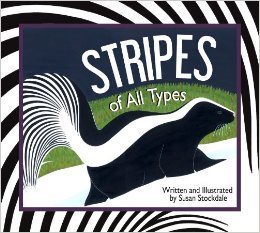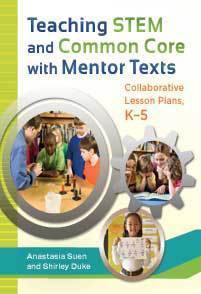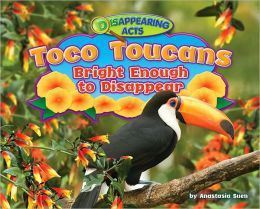Stripes of All Types
Stripes of All Types
by Susan Stockdale
Peachtree Publishers, 2013
ISBN #978-1-56145-695-6
Grades PreK-3
Nonfiction Picture Book
Exciting news! Anastasia Suen and I co-wrote a new book. It’s based on my blog and is packed full of lesson plans, STEM, mentor texts, and the Common Core.
Stripes of All Types follows animal life with stripes as part of their coloration in their native habitats. The book reveals simple information in a rollicking rhyme and bright art. It takes the reader from the ocean to land to a familiar striped animal at home.
Activity
Define the word “camouflage” in nature as protective coloring that helps animals hide in plain sight. Then show these images and together locate the animal. You may have to point out where it is in some pictures. Discuss why animals need to use camouflage and the ways it helps them.
Pair the book with the nonfiction book Toco Toucan Bright Enough to Disappear by Anastasia Suen. Compare the ways the toucan uses colors to the stripes in the Stripes of All Types book.
Next Generation Science Standards
K
ESS3.A: Natural Resources
§ Living things need water, air, and resources from the land, and they live in places that have the things they need. Humans use natural resources for everything they do. (K-ESS3-1)
ESS2.E: Biogeology
§ Plants and animals can change their environment. (K-ESS2-2)
1
LS1.A: Structure and Function
§ All organisms have external parts. Different animals use their body parts in different ways to see, hear, grasp objects, protect themselves, move from place to place, and seek, find, and take in food, water and air. Plants also have different parts (roots, stems, leaves, flowers, fruits) that help them survive and grow. (1-LS1-1)
LS1.B: Growth and Development of Organisms
§ Adult plants and animals can have young. In many kinds of animals, parents and the offspring themselves engage in behaviors that help the offspring to survive. (1-LS1-2)
LS1.D: Information Processing
§ Animals have body parts that capture and convey different kinds of information needed for growth and survival. Animals respond to these inputs with behaviors that help them survive. Plants also respond to some external inputs. (1-LS1-1)
LS3.A: Inheritance of Traits
§ Young animals are very much, but not exactly like, their parents. Plants also are very much, but not exactly, like their parents. (1-LS3-1)
LS3.B: Variation of Traits
§ Individuals of the same kind of plant or animal are recognizable as similar but can also vary in many ways. (1-LS3-1)
2
LS4.D: Biodiversity and Humans
§ There are many different kinds of living things in any area, and they exist in different places on land and in water. (2-LS4-1)
For a Common Core experience, discuss the main idea of the book. Use each spread and talk about how that animal’s stripes are located and positioned. Ask the listeners why animals have stripes. Then show the spread with the striped images. Identify each picture in turn to review the animals’ names and where they live.
CCSS.ELA-Literacy.CCRA.R.2 Determine central ideas or themes of a text and analyze their development; summarize the key supporting details and ideas.
CCSS.ELA-Literacy.CCRA.R.1 Read closely to determine what the text says explicitly and to make logical inferences from it; cite specific textual evidence when writing or speaking to support conclusions drawn from the text.
CCSS.ELA-Literacy.RI.K.1 With prompting and support, ask and answer questions about key details in a text.
CCSS.ELA-Literacy.RI.K.2 With prompting and support, identify the main topic and retell key details of a text.
CCSS.ELA-Literacy.RI.K.3 With prompting and support, describe the connection between two individuals, events, ideas, or pieces of information in a text.
CCSS.ELA-Literacy.RI.K.5 Identify the front cover, back cover, and title page of a book.
CCSS.ELA-Literacy.RI.K.6 Name the author and illustrator of a text and define the role of each in presenting the ideas or information in a text.
Look up the CCSS to see the remaining Literacy.RI.1-2 standards.


Shirley Smith Duke's Blog






